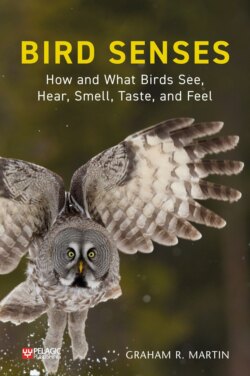Читать книгу Bird Senses - Graham R. Martin - Страница 30
На сайте Литреса книга снята с продажи.
Two-choice discrimination tasks
ОглавлениеThe most rigorous technique used in psychophysical investigations of birds usually involves a small number of individuals of a particular species being trained initially to make a choice between two quite different stimuli which are presented simultaneously. That is, it involves a ‘two-choice discrimination’ and trains the bird to indicate that it can differentiate between two stimuli. It is then a matter of altering those stimuli so that they become more similar until a point is reached where they cannot be told apart. This then defines the limit of a particular sensory ability.
The technique is perhaps most easily described by the example of an investigation of the limit of visual resolution. In this the investigator is seeking to determine the smallest spatial detail that a bird can see. Initially the bird is presented with two panels placed side by side, one showing a pattern of black and white stripes (a grating) oriented vertically, the other showing the same pattern oriented horizontally. The panels will be of the same size and brightness; all that differs is the orientation of the stripes. The birds will have already become used to taking small food items from a hopper or some other device in the area where the stimulus panels are displayed. Today the patterns might be shown on a computer screen or back-projected onto a panel, but previously stripe patterns on photographic negatives or printed on cards were used (Figure 2.7).
FIGURE 2.7 A schematic drawing of a setup used to determine visual acuity in a Harris’s Hawk Parabuteo unicinctus. The bird is given a two-choice task. It has been trained to wait on the perch until a pair of patterns is shown on the panels, which are 10 m away. As soon as the bird leaves the perch the patterns are switched off and the bird flies to the perch of its choice. If it flies to the perch in front of the ‘correct’ panel it receives a small food reward. The bird is observed remotely so that humans cannot influence its behaviour. Many such trials are conducted and the width of the stripes on the panels is altered in a random sequence. This allows the performance of the bird with respect to the width of the stripes on the test gratings to be measured, and a threshold stripe width can be determined (see Figure 2.8).
By the time the investigation gets to this point, the person running the investigation will have got to know the birds well, but will not be in direct contact with the birds. The birds’ behaviour will be remotely observed, so that the investigator cannot inadvertently influence the birds’ choices. The way the investigator influences the bird is through the presentation of food items which are paired with the presentation of only one type of stimulus panel, for example, the one with horizontal stripes. If the bird is hungry it will usually learn rapidly to move towards, or peck at, the panel with the horizontal stripes, as long as it reliably receives a food item each time it does so.
I have done vision investigations with doves who will peck directly at the panels for grain, owls that will peck at a bar beneath a panel to be rewarded by a small piece of meat, and with Great Cormorants who will swim up to a panel underwater in return for a small fish dropped to them through the surface. Some species can be trained to make their choice of panel from a fixed distance and then fly, swim, or walk towards the panel along a runway or swim-way. Owls seem particularly amenable to running, while diurnal birds of prey will readily fly from a start perch and land on a perch placed just in front of a panel.
In instances where flying, running, or swimming is involved, the bird must not be able to change its choice once it has passed a certain point. This ensures that the bird’s decision is always made a fixed distance from the panel. The use of a fixed distance is important for calculating the visual size of the object as seen by the bird and hence for defining its best performance. Depending on the species, it might be better for the bird to make a choice between relatively widely striped gratings at a long distance and fly to the panel (for example, a hawk), rather than choose between finer stripes at a closer distance (for example, a Budgerigar Melopsittacus undulatus). It is a matter of working with the bird’s natural behaviours to enable it to perform the choice task readily and hence reveal the ultimate limits of its vision.
Once this link between a target panel and the reinforcing food has become established, it is then a matter of starting to manipulate by small increments the task that the bird faces. The left–right positions of the panels will be changed randomly between trials, the light levels of the panels will be changed randomly over a wide range of light levels, and the widths of the stripes in the grating pairs will also be varied between trials. The point of these variations is to ensure that the bird is responding exclusively to the orientation of the stripes. In other words, that the bird has really learned that it is the orientation of the stripes that it should be attending to.
